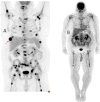Management of Primary Plasma Cell Leukemia Remains Challenging Even in the Era of Novel Agents
- PMID: 33716516
- PMCID: PMC7917418
- DOI: 10.1177/2634853521999389
Management of Primary Plasma Cell Leukemia Remains Challenging Even in the Era of Novel Agents
Abstract
Primary plasma cell leukemia (PCL) is a rare and aggressive variant of multiple myeloma (MM). PCL is characterized by peripheral blood involvement by malignant plasma cells and an aggressive clinical course leading to poor survival. There is considerable overlap between MM and PCL with respect to clinical, immunophenotypic, and cytogenetic features, but circulating plasma cell count exceeding 20% of peripheral blood leukocytes or an absolute plasma cell count of >2000/mm3 distinguishes it from MM. After initial stabilization and diagnosis confirmation, treatment of PCL in a fit patient typically includes induction combination chemotherapy containing novel agents typically, with proteasome inhibitors (such as bortezomib) and immunomodulatory drugs (eg, lenalidomide), followed by autologous hematopoietic stem cell transplant (HSCT) and multidrug maintenance therapy using novel agents post-HSCT. Long-term outcomes have improved employing this strategy but the prognosis for non-HSCT candidates remains poor and new approaches are needed for such PCL patients not eligible for HSCT. Here, we report a case of primary PCL, and a comprehensive and up to date review of the literature for diagnosis and management of PCL. We also present the findings of Positron Emission Tomography (PET) scan. Since PCL is often associated with extra-medulary disease, including PET scan at the time of staging and restaging may be a novel approach particularly to evaluate the extra-medullary disease sites.
Keywords: Plasma cell leukemia; autologous hematopoietic stem cell transplantation; multiple myeloma; novel agents.
© The Author(s) 2021.
Conflict of interest statement
Declaration of conflicting interests:The author(s) declared no potential conflicts of interest with respect to the research, authorship, and/or publication of this article.
Figures



References
-
- Sant M, Allemani C, Tereanu C, et al.. Incidence of hematologic malignancies in Europe by morphologic subtype: results of the HAEMACARE project. Blood. 2010;116:3724-3734. - PubMed
-
- Kyle RA, Maldonado JE, Bayrd ED. Plasma cell leukemia. Report on 17 cases. Arch Intern Med. 1974;133:813-818. - PubMed
-
- An G, Qin X, Acharya C, et al.. Multiple myeloma patients with low proportion of circulating plasma cells had similar survival with primary plasma cell leukemia patients. Ann Hematol. 2015;94:257-264. - PubMed
Publication types
LinkOut - more resources
Full Text Sources
Other Literature Sources

